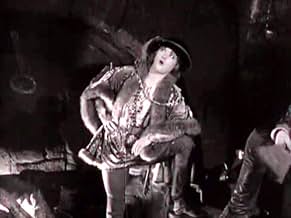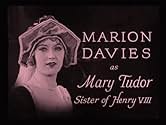When Knighthood Was in Flower
- 1922
- 2 Std.
IMDb-BEWERTUNG
6,6/10
1160
IHRE BEWERTUNG
Füge eine Handlung in deiner Sprache hinzuMary Tudor, sister of England's Henry VIII, causes a stir by falling in love with a guardsman below her class.Mary Tudor, sister of England's Henry VIII, causes a stir by falling in love with a guardsman below her class.Mary Tudor, sister of England's Henry VIII, causes a stir by falling in love with a guardsman below her class.
- Regie
- Drehbuch
- Hauptbesetzung
- Auszeichnungen
- 1 wins total
William Powell
- Francis, Duc d' Angoulême
- (as William H. Powell)
Charles K. Gerrard
- Sir Adam Judson
- (as Charles Gerard)
Empfohlene Bewertungen
Marion Davies brings a sense of fun and adventure to the role of Mary Tudor, the younger sister of Henry VIII, who was forced into marrying the ageing French King Louis XII. The entertaining plot revolves around her attempts to avoid the marriage and elope with dashing officer Charles Brandon (Forrest Stanley).. A big hit when it was released - and also the most expensive movie ever made for a while - it is undeservedly overlooked today.
Although he is not remembered to-day for anything else but this production, Robert G. Vignola directed no less than 99 movies, starting way back in 1911 and continuing through to 1937. A look at "The Scarlet Letter" (1934) confirms the impression that he learnt his craft back in 1911 and stuck with it. Throughout the entire length of "When Knighthood", Mr Vignola does not move his camera so much as a single half-inch. Were it not for his fondness of editing constantly from a group shot to a tight two-shot, the whole movie is otherwise presented as if it were a stage play. Nonetheless, he does maintain the pace of his tale with admirable dexterity. I was amazed to find that I'd been glued to the screen for well over two and half hours. I thought I'd been watching the action for no more than 90 minutes.
Of course the overwhelming richness of the production, tight plotting that most effectively builds up to two separate climaxes, plus spellbinding acting (particularly from Miss Davies herself, Lyn Harding, William Norris and William Powell) all contributed to the movie's appeal. On the other hand, I thought Forrest Stanley made a rather dull hero; and the fact that he and Ernest Glendinning who played his friend, Caskoden, were virtually interchangeable look-a-likes did not help.
All told, however, this is a thrilling, engrossing and visually appealing production, and I can't wait until it's released on DVD with an appropriate music score.
Of course the overwhelming richness of the production, tight plotting that most effectively builds up to two separate climaxes, plus spellbinding acting (particularly from Miss Davies herself, Lyn Harding, William Norris and William Powell) all contributed to the movie's appeal. On the other hand, I thought Forrest Stanley made a rather dull hero; and the fact that he and Ernest Glendinning who played his friend, Caskoden, were virtually interchangeable look-a-likes did not help.
All told, however, this is a thrilling, engrossing and visually appealing production, and I can't wait until it's released on DVD with an appropriate music score.
This 1922 production (now restored) was at the time the most expensive picture ever made. It was also a major box-office hit. Marion Davies plays Mary Tudor, sister of Henry VIII and intended bride of old Louis of France. But she's in love with the dashing Charles Brandon (Forrest Stanley). After Brandon is framed for murder, Mary agrees to bargain with Henry: he'll spare Brandon's life if she willingly marries old Louis. She counters that she will agree if she can choose her second husband. Henry agrees.
Mary goes off to France to marry old Louis (William Norris) but his nephew and heir (William Powell) has designs on beautiful Mary. After old Louis dies, the nephew pounces on Mary, but she escapes with Brandon's help in a race across France with an army in pursuit.
The breathtaking restoration on this film, with the original tinting scheme and digital hand-coloring restored, is a great achievement, one that lets us view this film as it was seen in 1922. The fabulous sets by Joseph Urban and costumes by Gretl Urban Thurlow make for a sumptuous film experience that enhances the exciting story of medieval court intrigue.
Marion Davies is nothing short of superb as Mary Tudor. She is willful, impetuous, determined, and throws herself into the role of the princess who, at one point, masquerades as a boy in an attempt to escape the English court of Henry. Forrest Stanley is a suitable Brandon, Lyn Harding is impressive as Henry. William Norris is terrific as old Louis. William Powell is appropriately oily as the king's nephew. Johnny Dooley plays the court jester who has an important scene.
Others include Ruth Shepley as Jane, Theresa Maxwell Conover as Queen Catherine, Flora Finch as a lady of the French court, Ernest Glendinning as Caskoden, Pedro de Cordoba as Buckingham, Arthur Forrest as Wolsey, Gustv von Seyffertitz as the soothsayer, Paul Panzer as captain of the guards, and William Kent as the court tailor. Nicely directed by Robert Vignola.
This is first and foremost a Marion Davies film, and she is spectacular. This new restoration (July 2107) is a must-see film for all fans of Davies in particular and silent films in general.
Mary goes off to France to marry old Louis (William Norris) but his nephew and heir (William Powell) has designs on beautiful Mary. After old Louis dies, the nephew pounces on Mary, but she escapes with Brandon's help in a race across France with an army in pursuit.
The breathtaking restoration on this film, with the original tinting scheme and digital hand-coloring restored, is a great achievement, one that lets us view this film as it was seen in 1922. The fabulous sets by Joseph Urban and costumes by Gretl Urban Thurlow make for a sumptuous film experience that enhances the exciting story of medieval court intrigue.
Marion Davies is nothing short of superb as Mary Tudor. She is willful, impetuous, determined, and throws herself into the role of the princess who, at one point, masquerades as a boy in an attempt to escape the English court of Henry. Forrest Stanley is a suitable Brandon, Lyn Harding is impressive as Henry. William Norris is terrific as old Louis. William Powell is appropriately oily as the king's nephew. Johnny Dooley plays the court jester who has an important scene.
Others include Ruth Shepley as Jane, Theresa Maxwell Conover as Queen Catherine, Flora Finch as a lady of the French court, Ernest Glendinning as Caskoden, Pedro de Cordoba as Buckingham, Arthur Forrest as Wolsey, Gustv von Seyffertitz as the soothsayer, Paul Panzer as captain of the guards, and William Kent as the court tailor. Nicely directed by Robert Vignola.
This is first and foremost a Marion Davies film, and she is spectacular. This new restoration (July 2107) is a must-see film for all fans of Davies in particular and silent films in general.
Mary Tudor (Marion Davies) falls in love with Charles Brandon but is forced for political reasons by elder brother Henry VIII to marry the old and decrepit King Louis XII of France.
Nice, big budget sets and costumes, but Marion Davies seems the wrong actor for her role. As swashbucklers go, rather tame.
Nice, big budget sets and costumes, but Marion Davies seems the wrong actor for her role. As swashbucklers go, rather tame.
Knights in Flowery Dresses is a masterfully costumed and filmed romp through the Court of the Crimson King. But it proves that as far back as 1922 William Randolph Hearst was spending lavish amounts of money trying to prove to the world Marion Davies could act.
Don't get me wrong. Davies was a gifted physical comic actress and mimic. When she's allowed to display those talents in movies, the movies are hugely entertaining. When Daddy Warbucks puts her in costume dramas, her complete lack of talent as a dramatic actor shines through.
I mean, if this is a drama, Davies doesn't act like she's in one. And if it's a comedy it's very unfunny. I know for sure it's not an epic because it barely leaves the castle.
Although the set design is elaborate and expensive, the film failed to hold my interest. Except for King Henry VIII's eyes, which appear to be made of chunks of coal. Very creepy.
Don't get me wrong. Davies was a gifted physical comic actress and mimic. When she's allowed to display those talents in movies, the movies are hugely entertaining. When Daddy Warbucks puts her in costume dramas, her complete lack of talent as a dramatic actor shines through.
I mean, if this is a drama, Davies doesn't act like she's in one. And if it's a comedy it's very unfunny. I know for sure it's not an epic because it barely leaves the castle.
Although the set design is elaborate and expensive, the film failed to hold my interest. Except for King Henry VIII's eyes, which appear to be made of chunks of coal. Very creepy.
Wusstest du schon
- WissenswertesMarion Davies's gowns were the exact reproductions of those worn by Mary Tudor.
- PatzerFrancis was Louis's son-in-law and first cousin once removed, not his nephew.
- Zitate
Mary Tudor: Jane, Jane, how lucky you are not to be a Princess... and for sale!
- VerbindungenEdited into American Experience: Citizen Hearst: Part 2 (2021)
- SoundtracksThe Marion Davies March
Music by Victor Herbert
Top-Auswahl
Melde dich zum Bewerten an und greife auf die Watchlist für personalisierte Empfehlungen zu.
Details
- Erscheinungsdatum
- Herkunftsland
- Sprachen
- Auch bekannt als
- Då ridderskapet stod i blom
- Drehorte
- Produktionsfirma
- Weitere beteiligte Unternehmen bei IMDbPro anzeigen
Box Office
- Budget
- 1.500.000 $ (geschätzt)
- Laufzeit
- 2 Std.(120 min)
- Farbe
- Sound-Mix
- Seitenverhältnis
- 1.33 : 1
Zu dieser Seite beitragen
Bearbeitung vorschlagen oder fehlenden Inhalt hinzufügen
































